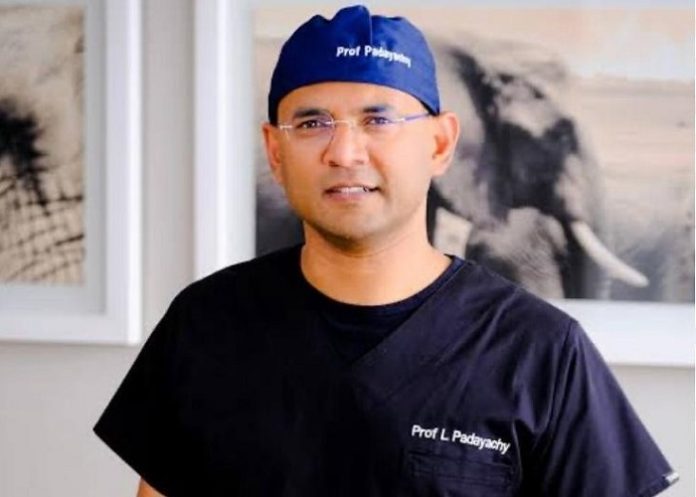A three-year-old is on the mend after high stakes surgery to remove a tumour involving the brainstem, thanks to Professor Llewellyn Padayachy and an inter-disciplinary team at the Steve Biko Academic Hospital.
The lengthy operation combined pioneering multi-modality monitoring and ultrasound to keep the patient as safe as possible, writes Matthew Hattingh for MedicalBrief.
Padayachy said the tumour was located in an “exquisitely sensitive part of the brain”, where angles are difficult, and the positioning is awkward, making the procedure high-risk.
Padayachy heads the Department of Neurosurgery at the University of Pretoria and is the chief specialist and paediatric neurosurgeon at the hospital. He is a leader in minimally invasive surgical techniques, experience which he drew on for the 4 August 2025 operation.
Neurophysiological monitoring, with electrical stimulation of the neural pathways, was used to assess the function of the nerve pathways, while ultrasound provided an additional structural imaging tool. This helped the surgeons assess “how much tumour is left, and where the blood vessels are”.
It was a fine, delicate undertaking, demanding surgical precision and the sensible use of adjunctive monitoring and imaging tools.
The patient had been referred to Steve Biko Academic from a private hospital, where she had been diagnosed. At that stage the child was already quite symptomatic, said Padayachy, noting severe movement abnormalities, visual impairment and significant symptoms of raised intracranial pressure.
The team knew from the outset their task would be a safe maximal resection of the tumour because of the extent to which it had become entangled with healthy brain tissue.
“Planning is essential and everything that we can do to make the procedure as safe as possible, and leave the child in the best neurological state, is always our goal,” said Padayachy.
He referenced the celebrated British neurologist John Garfield to the effect that you can teach when to operate, but it is difficult to teach when not to operate, and perhaps even more difficult to teach when to stop the operation. “(The skilled surgeon) understands the complexity of doing what's best for the patient.”
The child will be receiving adjuvant radiation therapy. He said although the operation came with a big risk of swallowing and breathing impairment, the team had succeeded in clearing the child’s lungs. She had come off the ventilator after a couple of days. Her breathing was now comfortable; her swallowing intact.
Padayachy confirmed the patient had made a good recovery. Her cognitive function was back to baseline and was mobilising well too. “In fact, she has done as well as we could have hoped for her to do.”
Intensive physio, occupational therapy and speech therapy always followed to optimise the outcome of care, said Padayachy.
He gave credit to his team, mentioning two senior neurosurgeons, chief registrars, who were looking to refine their skills and had assisted him, along with a junior-level registrar and “our talented neurophysiologist”.
He said the Brain Tumour and Translational Neuroscience Centre at the University of Pretoria had over the years attracted talented research students and built capacity that it could now call on.
Dr Lehlohonolo Majake-Mogoba, chief executive of Steve Biko Academic Hospital, hailed the achievement as a beacon of excellence in South Africa’s public healthcare system. “This is a proud moment for our institution and for the country. It reflects the brilliance, dedication, and heart of our medical professionals,” she said.
“We are proving world-class care is not confined to private institutions; it thrives here, in the public sector, where service and compassion are our guiding principles. It shows that when we invest in our people, equip our facilities, and believe in the power of public service, we can transform lives.”
Professor Flavia Senkubuge, Dean of the Faculty of Health Sciences at the University of Pretoria, praised Padayachy and the hospital team for a “remarkable achievement”. It was a testament to the power of clinical excellence, innovation and public health care, she said.

